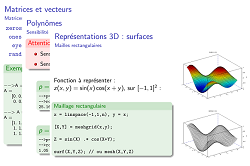

The command returns all the elements of the first row in the order of their appearance in the row. For example, first row of E can be obtained using the following command: It is easy to extract an entire row or an entire column of a matrix in Scilab. To access the element in the first row and second column, type:
SCILAB OUTPUT MATRIX HOW TO
Let us now see how to address individual elements of a matrix, separately. Recall that in the Spoken Tutorial, 'Vector Operations', matrix E was defined as It is suggested that the user should practice this tutorial in Scilab simultaneously while pausing the video at regular intervals of time. Start Scilab by double-clicking on the Scilab icon present on the Desktop.
SCILAB OUTPUT MATRIX WINDOWS 7

Or by inserting the elements of the column using the “ ” terminator: ->V2=

We can define the vector either by inserting the elements of the row: ->V1= If not Scilab will output a error message: ->C=Ī vector is in fact a matrix but only with one row or column. If the first row has 4 elements, for exemple, the second row has to have the same length. The matrix definition has to be consistent. In the same way a 2×4 matrix can be defined: ->B= In the same manner rows 2 and 3 are defined. In order to complete the definition of the first row “ ” is used. First are entered the values for the first row “1 2 3”. In Scilab, a variable of type matrix is defined in the following way: ->A=

It has a lot of built-in functions that allows the user to perform complex computations and manipulations on vectors (1-D matrices) and matrices. As Matlab®, Scilab is very powerful at computations with variables such as vectors and matrices.


 0 kommentar(er)
0 kommentar(er)
